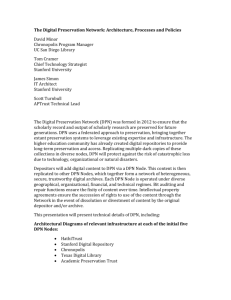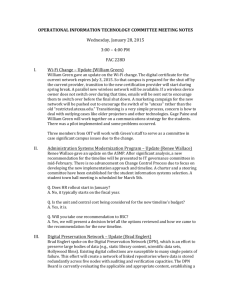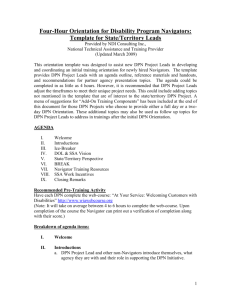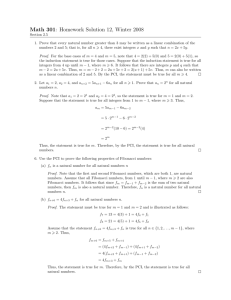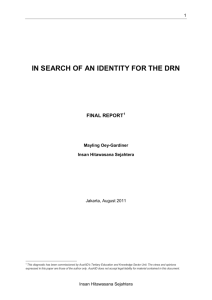Identities for the Common Factors of Fibonacci and Lucas
advertisement
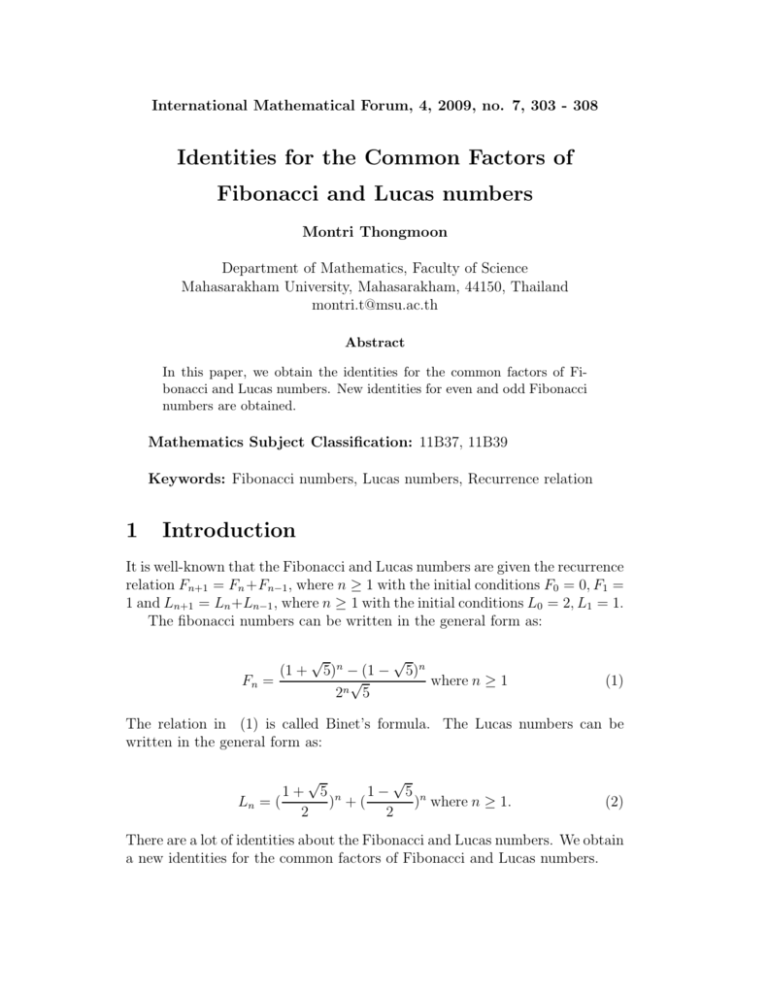
International Mathematical Forum, 4, 2009, no. 7, 303 - 308 Identities for the Common Factors of Fibonacci and Lucas numbers Montri Thongmoon Department of Mathematics, Faculty of Science Mahasarakham University, Mahasarakham, 44150, Thailand montri.t@msu.ac.th Abstract In this paper, we obtain the identities for the common factors of Fibonacci and Lucas numbers. New identities for even and odd Fibonacci numbers are obtained. Mathematics Subject Classification: 11B37, 11B39 Keywords: Fibonacci numbers, Lucas numbers, Recurrence relation 1 Introduction It is well-known that the Fibonacci and Lucas numbers are given the recurrence relation Fn+1 = Fn +Fn−1 , where n ≥ 1 with the initial conditions F0 = 0, F1 = 1 and Ln+1 = Ln +Ln−1 , where n ≥ 1 with the initial conditions L0 = 2, L1 = 1. The fibonacci numbers can be written in the general form as: Fn = (1 + √ 5)n − (1 − √ 2n 5 √ 5)n where n ≥ 1 (1) The relation in (1) is called Binet’s formula. The Lucas numbers can be written in the general form as: √ √ 1+ 5 n 1− 5 n Ln = ( ) +( ) where n ≥ 1. 2 2 (2) There are a lot of identities about the Fibonacci and Lucas numbers. We obtain a new identities for the common factors of Fibonacci and Lucas numbers. 304 2 M. Thongmoon Identities for the common factors of Fibonacci and Lucas numbers Theorem 1 F4n + 1 = F2n−1 L2n+1 where n ≥ 1. Proof. √ √ √ 5)2n−1 −(1− 5)2n−1 1+ 5 2n+1 √ ][( ) 2 22n−1 5 √ √ √ √ 5)2n−1 −(1− 5)2n−1 (1+ 5)2n+1 +(1− 5)2n+1 √ ][( ] 22n+1 22n−1 5 F2n−1 L2n+1 = [ (1+ = [ (1+ √ = F4n + [ (1+ √ + ( 1−2 5 )2n+1 ] √ 5)(1− 5) 2n ] 2 2 = F4n + (−1)2n = F4n + 1 Theorem 2 F4n+1 + 1 = F2n+1 L2n where n ≥ 1. Proof. √ √ √ 5)2n−1 −(1− 5)2n−1 1+ 5 2n √ ][( ) 2n−1 2 2 5 √ √ √ √ 5)2n−1 −(1− 5)2n−1 (1+ 5)2n +(1− 5)2n √ ][( ] 2n 2n−1 2 2 5 F2n−1 L2n = [ (1+ = [ (1+ √ = F4n+1 + [ (1+ √ 5)(1− 5) 2n ] 22 = F4n+1 + (−1)2n = F4n+1 + 1 Theorem 3 F4n+2 + 1 = F2n+2 L2n where n ≥ 1. √ + ( 1−2 5 )2n ] 305 Fibonacci and Lucas numbers Proof. √ √ √ 5)2n+2 −(1− 5)2n+2 1+ 5 2n √ ][( ) 2 22n+2 5 √ √ √ √ 5)2n+2 −(1− 5)2n+2 (1+ 5)2n +(1− 5)2n √ ][( ] 22n 22n+2 5 F2n+2 L2n = [ (1+ = [ (1+ = F4n+2 + √ + ( 1−2 5 )2n ] √ √ (1+ 5)(1− 5) 2n [ ] 22 = F4n+2 + (−1)2n = F4n+2 + 1 By the same way, we have the following result: Theorem 4 F4n+3 + 1 = F2n+1 L2n+2 where n ≥ 1. Lemma 5 Fn Ln = F2n where n ≥ 1. Proof. √ Fn Ln = [ (1+ √ √ √ 5)n −(1− 5)n 1+ 5 n √ ][( ) n 2 2 5 n 5) √ − = [ (1+ 2n 5 = √ (1+ 5)2n [ 22n √5 √ = [ (1+ − √ + ( 1−2 5 )n ] √ √ (1− 5)n 1+ 5 n √ ][( ) 2 2n 5 √ + ( 1−2 5 )n ] √ (1− 5)2n √ ] 22n 5 √ 5)2n −(1− 5)2n √ ] 22n 5 = F2n Lemma 6 F4n+1 − 1 = F2n L2n+1 where n ≥ 1. Proof. √ √ √ 5)2n −(1− 5)2n 1+ 5 2n+1 √ ][( ) 2n 2 2 5 √ √ √ √ 5)2n −(1− 5)2n (1+ 5)2n+1 +(1− 5)2n+1 √ ][( ] 22n+1 22n 5 F2n L2n+1 = [ (1+ = [ (1+ = F4n+1 − √ √ (1+ 5)(1− 5) 2n [ ] 22 = F4n+1 − (−1)2n = F4n+1 − 1 √ + ( 1−2 5 )2n+1 ] 306 M. Thongmoon From Lemma 5 and Lemma 6, we have the following result: Corollary 7 F4n+1 − 1 = Fn Ln L2n+1 where n ≥ 1. Lemma 8 L4n+1 − 1 = 5F2n F2n+1 where n ≥ 1. Proof. √ 5F2n F2n+1 = 5[ (1+ √ = [ (1+ √ √ √ 5)2n −(1− 5)2n (1+ 5)2n+1 −(1− 5)2n+1 √ √ ][ ] 22n 5 22n+1 5 √ 5)4n+1 +(1− 5)4n+1 ] 4n+1 2 = L4n+1 − √ − [( (1+ √ √ √ 5)2n+1 (1− 5)2n +(1+ 5)2n (1− 5)2n+1 ] 4n+1 2 √ √ (1+ 5)(1− 5) 2n [ ] 22 = L4n+1 − (−1)2n = L4n+1 − 1 Theorem 9 L4n+1 − 1 = 5Fn Ln F2n+1 where n ≥ 1. Proof. Substituting F2n = Fn Ln from Lemma 5 into Lemma 8, then the prove is completed. Theorem 10 L4n+1 + 1 = L2n L2n+1 where n ≥ 1. Proof. √ √ √ √ L2n L2n+1 = [( 1+2 5 )2n + ( 1−2 5 )2n ][( 1+2 5 )2n+1 + ( 1−2 5 )2n+1 ] √ = [ (1+ √ 5)4n+1 +(1− 5)4n+1 ] 24n+1 √ = L4n+1 + [ (1+ √ + [( (1+ √ √ √ 5)2n+1 (1− 5)2n +(1+ 5)2n (1− 5)2n+1 ] 24n+1 √ 5)(1− 5) 2n ] 22 = L4n+1 + (−1)2n = L4n+1 + 1 Lemma 11 F4n+3 − 1 = F2n+2 L2n+1 where n ≥ 1. 307 Fibonacci and Lucas numbers Proof. √ √ √ 5)2n+2 −(1− 5)2n+2 1+ 5 2n+1 √ ][( ) 2n+2 2 2 5 √ √ √ √ 5)2n+2 −(1− 5)2n+2 (1+ 5)2n+1 +(1− 5)2n+1 √ ][( ] 2n+1 2n+2 2 2 5 F2n+2 L2n+1 = [ (1+ = [ (1+ √ = F4n+3 − [ (1+ √ + ( 1−2 5 )2n+1 ] √ 5)(1− 5) 2n ] 22 = F4n+3 − (−1)2n = F4n+3 − 1 Theorem 12 F4n+3 − 1 = Fn+1 Ln+1 L2n+1 where n ≥ 1. Proof. Substituting F2n+2 = Fn+1 Ln+1 from Lemma 5 into Lemma 11, then the prove is completed. Theorem 13 L4n+3 − 1 = L2n+1 L2n+2 where n ≥ 1. Proof. √ √ √ √ L2n+1 L2n+2 = [( 1+2 5 )2n+1 + ( 1−2 5 )2n+1 ][( 1+2 5 )2n+2 + ( 1−2 5 )2n+2 ] √ = [ (1+ √ 5)4n+3 +(1− 5)4n+3 ] 4n+3 2 √ = L4n+3 + [ (1+ √ + [( (1+ √ √ √ 5)2n+2 (1− 5)2n+1 +(1+ 5)2n+1 (1− 5)2n+2 ] 4n+3 2 √ 5)(1− 5) 2n+1 ] 2 2 = L4n+3 + (−1)2n+1 = L4n+3 − 1 Since F2n+2 = Fn+1 Ln+1 where n ≥ 1. Then we have the following result: Lemma 14 L4n+3 + 1 = 5F2n+2 F2n+1 where n ≥ 1. Proof. √ 5F2n+2 F2n+1 = 5[ (1+ = √ √ √ 5)2n+2 −(1− 5)2n+2 (1+ 5)2n+1 −(1− 5)2n+1 √ √ ][ ] 22n+2 5 22n+1 5 √ √ √ √ √ √ (1+ 5)4n+3 −(1− 5)4n+3 (1− 5)2n+2 (1+ 5)2n+1 +(1− 5)2n+1 (1+ 5)2n+2 ][( ] [ 24n+3 24n+3 = L4n+3 + √ √ (1+ 5)(1− 5) 2n [ ] 22 = L4n+3 + (−1)2n = L4n+3 + 1 308 M. Thongmoon Substituting F2n+2 = Fn+1 Ln+1 into Lemma 14, then we have the following result: Corollary 15 L4n+3 + 1 = 5Ln+1 Fn+1 F2n+1 where n ≥ 1. References [1] H. Dubner and W. Keller, New Fibonacci and Lucas primes, Mathematics of Computation, 68(1999), 417-427. [2] T. Koshy, Fibonacci and Lucas Numbers with Applications, A Wiley- Interscience Publication, New York, 2001. Received: September 23, 2008



